Fabian Manhardt
LODGE: Level-of-Detail Large-Scale Gaussian Splatting with Efficient Rendering
May 29, 2025Abstract:In this work, we present a novel level-of-detail (LOD) method for 3D Gaussian Splatting that enables real-time rendering of large-scale scenes on memory-constrained devices. Our approach introduces a hierarchical LOD representation that iteratively selects optimal subsets of Gaussians based on camera distance, thus largely reducing both rendering time and GPU memory usage. We construct each LOD level by applying a depth-aware 3D smoothing filter, followed by importance-based pruning and fine-tuning to maintain visual fidelity. To further reduce memory overhead, we partition the scene into spatial chunks and dynamically load only relevant Gaussians during rendering, employing an opacity-blending mechanism to avoid visual artifacts at chunk boundaries. Our method achieves state-of-the-art performance on both outdoor (Hierarchical 3DGS) and indoor (Zip-NeRF) datasets, delivering high-quality renderings with reduced latency and memory requirements.
CubeDiff: Repurposing Diffusion-Based Image Models for Panorama Generation
Jan 28, 2025Abstract:We introduce a novel method for generating 360{\deg} panoramas from text prompts or images. Our approach leverages recent advances in 3D generation by employing multi-view diffusion models to jointly synthesize the six faces of a cubemap. Unlike previous methods that rely on processing equirectangular projections or autoregressive generation, our method treats each face as a standard perspective image, simplifying the generation process and enabling the use of existing multi-view diffusion models. We demonstrate that these models can be adapted to produce high-quality cubemaps without requiring correspondence-aware attention layers. Our model allows for fine-grained text control, generates high resolution panorama images and generalizes well beyond its training set, whilst achieving state-of-the-art results, both qualitatively and quantitatively. Project page: https://cubediff.github.io/
Mixed Diffusion for 3D Indoor Scene Synthesis
May 31, 2024



Abstract:Realistic conditional 3D scene synthesis significantly enhances and accelerates the creation of virtual environments, which can also provide extensive training data for computer vision and robotics research among other applications. Diffusion models have shown great performance in related applications, e.g., making precise arrangements of unordered sets. However, these models have not been fully explored in floor-conditioned scene synthesis problems. We present MiDiffusion, a novel mixed discrete-continuous diffusion model architecture, designed to synthesize plausible 3D indoor scenes from given room types, floor plans, and potentially pre-existing objects. We represent a scene layout by a 2D floor plan and a set of objects, each defined by its category, location, size, and orientation. Our approach uniquely implements structured corruption across the mixed discrete semantic and continuous geometric domains, resulting in a better conditioned problem for the reverse denoising step. We evaluate our approach on the 3D-FRONT dataset. Our experimental results demonstrate that MiDiffusion substantially outperforms state-of-the-art autoregressive and diffusion models in floor-conditioned 3D scene synthesis. In addition, our models can handle partial object constraints via a corruption-and-masking strategy without task specific training. We show MiDiffusion maintains clear advantages over existing approaches in scene completion and furniture arrangement experiments.
OpenNeRF: Open Set 3D Neural Scene Segmentation with Pixel-Wise Features and Rendered Novel Views
Apr 04, 2024


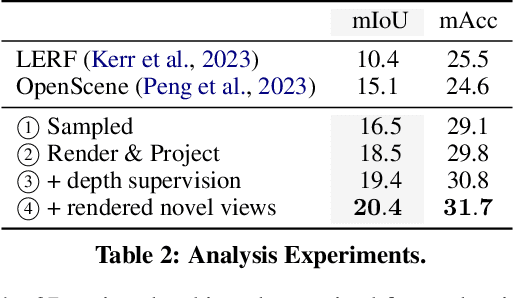
Abstract:Large visual-language models (VLMs), like CLIP, enable open-set image segmentation to segment arbitrary concepts from an image in a zero-shot manner. This goes beyond the traditional closed-set assumption, i.e., where models can only segment classes from a pre-defined training set. More recently, first works on open-set segmentation in 3D scenes have appeared in the literature. These methods are heavily influenced by closed-set 3D convolutional approaches that process point clouds or polygon meshes. However, these 3D scene representations do not align well with the image-based nature of the visual-language models. Indeed, point cloud and 3D meshes typically have a lower resolution than images and the reconstructed 3D scene geometry might not project well to the underlying 2D image sequences used to compute pixel-aligned CLIP features. To address these challenges, we propose OpenNeRF which naturally operates on posed images and directly encodes the VLM features within the NeRF. This is similar in spirit to LERF, however our work shows that using pixel-wise VLM features (instead of global CLIP features) results in an overall less complex architecture without the need for additional DINO regularization. Our OpenNeRF further leverages NeRF's ability to render novel views and extract open-set VLM features from areas that are not well observed in the initial posed images. For 3D point cloud segmentation on the Replica dataset, OpenNeRF outperforms recent open-vocabulary methods such as LERF and OpenScene by at least +4.9 mIoU.
* ICLR 2024, Project page: https://opennerf.github.io
KP-RED: Exploiting Semantic Keypoints for Joint 3D Shape Retrieval and Deformation
Mar 20, 2024
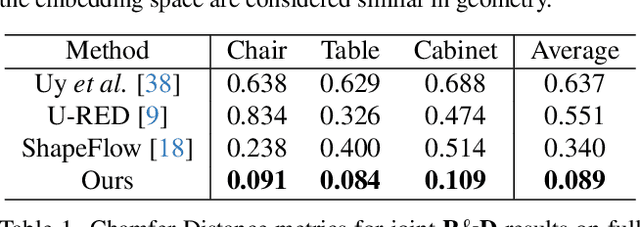


Abstract:In this paper, we present KP-RED, a unified KeyPoint-driven REtrieval and Deformation framework that takes object scans as input and jointly retrieves and deforms the most geometrically similar CAD models from a pre-processed database to tightly match the target. Unlike existing dense matching based methods that typically struggle with noisy partial scans, we propose to leverage category-consistent sparse keypoints to naturally handle both full and partial object scans. Specifically, we first employ a lightweight retrieval module to establish a keypoint-based embedding space, measuring the similarity among objects by dynamically aggregating deformation-aware local-global features around extracted keypoints. Objects that are close in the embedding space are considered similar in geometry. Then we introduce the neural cage-based deformation module that estimates the influence vector of each keypoint upon cage vertices inside its local support region to control the deformation of the retrieved shape. Extensive experiments on the synthetic dataset PartNet and the real-world dataset Scan2CAD demonstrate that KP-RED surpasses existing state-of-the-art approaches by a large margin. Codes and trained models will be released in https://github.com/lolrudy/KP-RED.
RadSplat: Radiance Field-Informed Gaussian Splatting for Robust Real-Time Rendering with 900+ FPS
Mar 20, 2024



Abstract:Recent advances in view synthesis and real-time rendering have achieved photorealistic quality at impressive rendering speeds. While Radiance Field-based methods achieve state-of-the-art quality in challenging scenarios such as in-the-wild captures and large-scale scenes, they often suffer from excessively high compute requirements linked to volumetric rendering. Gaussian Splatting-based methods, on the other hand, rely on rasterization and naturally achieve real-time rendering but suffer from brittle optimization heuristics that underperform on more challenging scenes. In this work, we present RadSplat, a lightweight method for robust real-time rendering of complex scenes. Our main contributions are threefold. First, we use radiance fields as a prior and supervision signal for optimizing point-based scene representations, leading to improved quality and more robust optimization. Next, we develop a novel pruning technique reducing the overall point count while maintaining high quality, leading to smaller and more compact scene representations with faster inference speeds. Finally, we propose a novel test-time filtering approach that further accelerates rendering and allows to scale to larger, house-sized scenes. We find that our method enables state-of-the-art synthesis of complex captures at 900+ FPS.
Denoising Diffusion via Image-Based Rendering
Feb 05, 2024



Abstract:Generating 3D scenes is a challenging open problem, which requires synthesizing plausible content that is fully consistent in 3D space. While recent methods such as neural radiance fields excel at view synthesis and 3D reconstruction, they cannot synthesize plausible details in unobserved regions since they lack a generative capability. Conversely, existing generative methods are typically not capable of reconstructing detailed, large-scale scenes in the wild, as they use limited-capacity 3D scene representations, require aligned camera poses, or rely on additional regularizers. In this work, we introduce the first diffusion model able to perform fast, detailed reconstruction and generation of real-world 3D scenes. To achieve this, we make three contributions. First, we introduce a new neural scene representation, IB-planes, that can efficiently and accurately represent large 3D scenes, dynamically allocating more capacity as needed to capture details visible in each image. Second, we propose a denoising-diffusion framework to learn a prior over this novel 3D scene representation, using only 2D images without the need for any additional supervision signal such as masks or depths. This supports 3D reconstruction and generation in a unified architecture. Third, we develop a principled approach to avoid trivial 3D solutions when integrating the image-based rendering with the diffusion model, by dropping out representations of some images. We evaluate the model on several challenging datasets of real and synthetic images, and demonstrate superior results on generation, novel view synthesis and 3D reconstruction.
HACD: Hand-Aware Conditional Diffusion for Monocular Hand-Held Object Reconstruction
Nov 23, 2023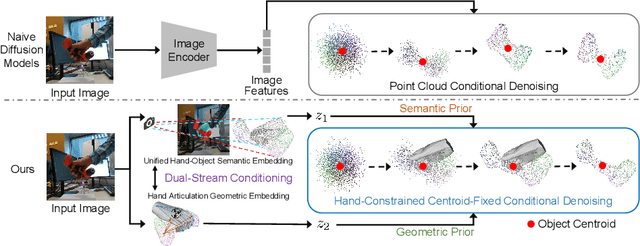

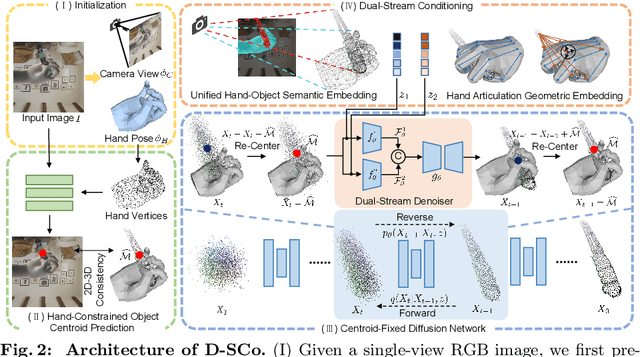
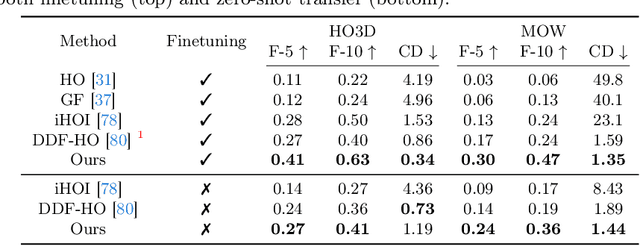
Abstract:Reconstructing hand-held objects from a single RGB image without known 3D object templates, category prior, or depth information is a vital yet challenging problem in computer vision. In contrast to prior works that utilize deterministic modeling paradigms, which make it hard to account for the uncertainties introduced by hand- and self-occlusion, we employ a probabilistic point cloud denoising diffusion model to tackle the above challenge. In this work, we present Hand-Aware Conditional Diffusion for monocular hand-held object reconstruction (HACD), modeling the hand-object interaction in two aspects. First, we introduce hand-aware conditioning to model hand-object interaction from both semantic and geometric perspectives. Specifically, a unified hand-object semantic embedding compensates for the 2D local feature deficiency induced by hand occlusion, and a hand articulation embedding further encodes the relationship between object vertices and hand joints. Second, we propose a hand-constrained centroid fixing scheme, which utilizes hand vertices priors to restrict the centroid deviation of partially denoised point cloud during diffusion and reverse process. Removing the centroid bias interference allows the diffusion models to focus on the reconstruction of shape, thus enhancing the stability and precision of local feature projection. Experiments on the synthetic ObMan dataset and two real-world datasets, HO3D and MOW, demonstrate our approach surpasses all existing methods by a large margin.
HiPose: Hierarchical Binary Surface Encoding and Correspondence Pruning for RGB-D 6DoF Object Pose Estimation
Nov 21, 2023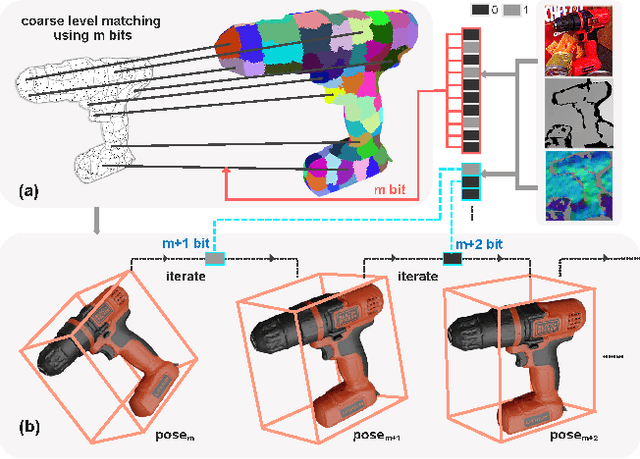
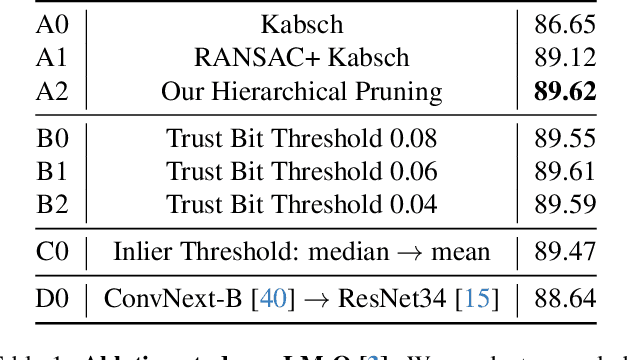
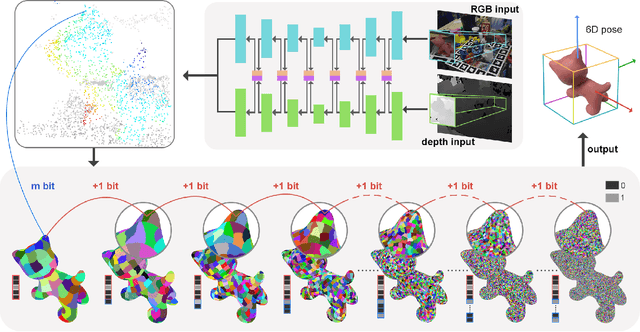

Abstract:In this work, we present a novel dense-correspondence method for 6DoF object pose estimation from a single RGB-D image. While many existing data-driven methods achieve impressive performance, they tend to be time-consuming due to their reliance on rendering-based refinement approaches. To circumvent this limitation, we present HiPose, which establishes 3D-3D correspondences in a coarse-to-fine manner with a hierarchical binary surface encoding. Unlike previous dense-correspondence methods, we estimate the correspondence surface by employing point-to-surface matching and iteratively constricting the surface until it becomes a correspondence point while gradually removing outliers. Extensive experiments on public benchmarks LM-O, YCB-V, and T-Less demonstrate that our method surpasses all refinement-free methods and is even on par with expensive refinement-based approaches. Crucially, our approach is computationally efficient and enables real-time critical applications with high accuracy requirements. Code and models will be released.
SecondPose: SE(3)-Consistent Dual-Stream Feature Fusion for Category-Level Pose Estimation
Nov 18, 2023



Abstract:Category-level object pose estimation, aiming to predict the 6D pose and 3D size of objects from known categories, typically struggles with large intra-class shape variation. Existing works utilizing mean shapes often fall short of capturing this variation. To address this issue, we present SecondPose, a novel approach integrating object-specific geometric features with semantic category priors from DINOv2. Leveraging the advantage of DINOv2 in providing SE(3)-consistent semantic features, we hierarchically extract two types of SE(3)-invariant geometric features to further encapsulate local-to-global object-specific information. These geometric features are then point-aligned with DINOv2 features to establish a consistent object representation under SE(3) transformations, facilitating the mapping from camera space to the pre-defined canonical space, thus further enhancing pose estimation. Extensive experiments on NOCS-REAL275 demonstrate that SecondPose achieves a 12.4% leap forward over the state-of-the-art. Moreover, on a more complex dataset HouseCat6D which provides photometrically challenging objects, SecondPose still surpasses other competitors by a large margin. The code will be released soon.
 Add to Chrome
Add to Chrome Add to Firefox
Add to Firefox Add to Edge
Add to Edge